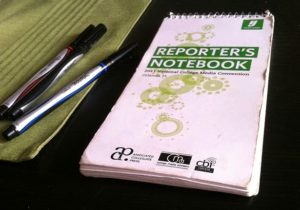When I read stories these days about newspapers’ shrinking newsrooms, I remember how it used to be in print journalism.
I was fortunate enough to be part of two newspapers that sold enough copies each day and raked in enough advertising money to invest deeply in personnel who were assigned to cover specific issues, work specific “beats.”
The most recent present-day tale I read came from Politico and it tells the story of the Des Moines (Iowa) Register, the one-time media titan in a state where presidential politics kicks off every four years with those vaunted Iowa caucuses. The Register, as are all newspapers these days, is retrenching. It is doing as much with fewer individuals to do it.
Read the Politico story here.
In the 1980s and into the 1990s, newspapers were flush with cash. I went from a small, five-day-a-week afternoon suburban daily in Oregon City, Ore., in 1984 to a mid-sized newspaper in Beaumont, Texas. I couldn’t believe my good fortune. The Beaumont Enterprise had a huge staff of reporters. They were assigned many specific beats.
The paper had an education reporter, police reporter, entertainment reporter, environmental reporter, courts reporter, someone to cover City Hall, someone to cover county government, reporters assigned to cover surrounding communities, we had a business editor who had a reporter working under his supervision. Then we had a sports department with about 10 reporters, including someone who covered “outdoor sports,” meaning chiefly huntin’ and fishin’. We had a photo staff of around six photographers.
Then, of course, we had copy editors, line editors who assigned stories to the reporters.
Then we had an editorial page staff, of which I was a member. I went to work in Beaumont as an editorial writer. The page had an editor and a cartoonist.
The Beaumont Enterprise, as the saying goes, was a “cash cow” for Jefferson Pilot, the owners who ran the paper when I got there and then for the Hearst Corporation, which bought the paper late in 1984.
I stayed for nearly 11 years before gravitating from the Gulf Coast to the Texas Panhandle. My professional journey then took me to a post where I served as editorial page editor for two papers in Amarillo, the morning Daily News and the evening Globe-Times.
The Globe-News, as everyone called it, was as rich as the Enterprise. The staff there was as diversified and exclusive as the paper I had departed. Its reach was enormous, covering the Panhandle, eastern New Mexico, the Oklahoma Panhandle and a small slice of southwestern Kansas.
Then the bottom started to fall out. It happened in the early 2000s. The Globe-Times was shuttered. The paper began to retrench. I heard that the Beaumont Enterprise did the same thing.
But the good old days were grand, indeed. They brought lots of fun, fellowship with colleagues and a joint pride in being able to assemble a publication each day of the week.
I don’t sense as much pride these days in the publications that employed me. Neither paper has nearly the staff they had back when they were flush with money.
I just recall all those friends and colleagues who have gone on to “pursue other interests.” I think of them often and hope they’re all as happy I am now that it’s over.
